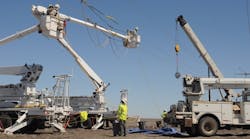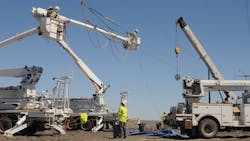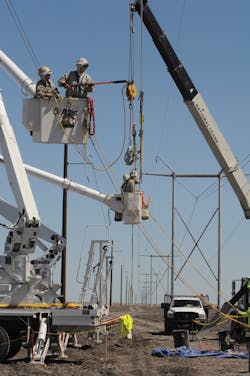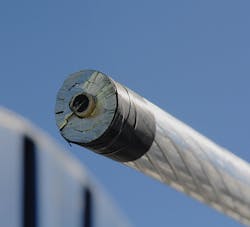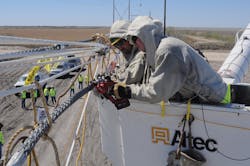Since 1996, American Electric Power’s (AEP’s) peak load in southern Texas, U.S., has grown 80%, hitting a record 2,378 MW in the winter of 2010. Forecasts predict load will climb to more than 3,000 MW by the end of this decade, and that growth requires sufficient transmission to connect generation to this load.
Although the design and siting of transmission need not be overly complex, locating and building new transmission can be incredibly difficult to pull off in a timely fashion. At present, the Lower Rio Grande Valley (LRGV) is served by two single-circuit 345-kV lines that originate from Corpus Christi, 120 miles (193 km) to the north. Installed in the early 1970s, both lines have been affected by hurricanes, and they are close enough to the Gulf of Mexico to have been exposed to corrosive salt spray, as well.
The Dilemma
As a result of Texas’ deregulation of the electric industry in the late 1990s, AEP divested its generation facilities in Texas, including two gas-fired plants in LRGV totaling 437 MW. That left only 1,592 MW of power from three combined-cycle generating stations for the LRGV, putting the load-serving capability in the area within unacceptable limits of the import capability for the existing transmission system during contingency situations. AEP has had long-standing transmission projects on the shelf to address those reliability concerns, which were caused by the cumulative effects of increasing load and decreasing generation.
In spite of the dilemma, load projections were unable to justify construction of new major lines into the area until later in this decade or early in the next, because the area’s generation requirements could be met by several new wind farms. That assessment was challenged when the LRGV experienced extremely cold temperatures between Feb. 2 and Feb. 5, 2011, triggering a record peak load demand of around 2,730 MW. This load exceeded the 2011 summer peak demand for the region by 500 MW.
Compounding the problem, generation in LRGV had been reduced during the 2011 cold spell because of a scheduled maintenance outage of a 450-MW unit in the west valley.
This all led to transmission imports into the region of nearly 2,000 MW, levels surpassing the transmission system transfer limitations. Consequently, 300 MW of load had to be shed manually to protect the transmission system from voltage collapse, line overloads, uncontrolled loss of load and cascading outages.
AEP’s Strategy
In March 2011, AEP went to the shelf, updated its proposal and submitted it to the regional planning group at the Electric Reliability Council of Texas (ERCOT). The project, which ERCOT approved, called for building a new 345-kV line from Laredo to North Edinburg, thus providing a third geographically diverse 345-kV source to the region, which would serve the northwest part of the LRGV.
ERCOT also endorsed AEP’s plan to perform an energized reconductor of the existing Lon Hill-to-North Edinburg and Lon Hill-to-Rio Hondo 345-kV transmission lines. AEP chose this strategy because of the import limitations and restricted outage clearances on both lines. Outages would be granted for the spring and summer months, if at all, but the lines would be required back in service within hours whenever system anomalies warranted.
Both existing lines are tubular-steel H-frame construction supporting a vertical two-conductor bundle of 795 kcmil aluminum conductor steel-reinforced Drake on polymer insulators. The normal summer rating of each line is approximately 1,769 A. To gain a 75% increase in ampacity, without wholesale structure replacements, the ACSR is being replaced with aluminum conductor composite core (ACCC) Drake (1020/TW) in the same vertical configuration. The resulting new normal summer rating will be 3,099 A.
This live-line reconductoring, requiring 1,440 miles (2,317 km) of conductor, will be the largest ACCC deployment in the United States. AEP chose ACCC for its high load capacity, strength and resistance to corrosion. The well-tested product, manufactured by CTC Global, can replace the existing line without increasing clearances or rights-of-way.
AEP also has had prior success with the advanced conductor. In early 2006, the utility completed its first reconductoring project using ACCC near San Antonio, Texas. In spite of an installation mishap, the experience inspired lab studies that led AEP’s technical team to develop a sequential mechanical test to assess conductor longevity, based on installation stresses, mechanical loads, Aeolian vibration and galloping. Test results verified the conductor’s attributes and toughness, encouraging AEP to complete seven other ACCC installations without incident. These successes paved the way for ACCC use in the Texas live-line reconductor project.
Division of Labor
In 2011, AEP went to Quanta Energized Services (QES), an entity of Quanta Services, with its plan to reconductor while energized two 345-kV transmission lines in southern Texas because of the contractor’s longtime experience doing this type of work. AEP’s safety-first culture matched up with Quanta’s, as the company had safely performed a live-line reconductoring of four 88-kV transmission lines, approximately 43 miles (69 km), for City Power in Johannesburg, South Africa, using the advanced ACCC conductor.
After the AEP visit, QES immediately dispatched a team to Texas to look at the existing lines and develop a work method to safely and cost-effectively meet the utility’s goals. At that point, North Houston Pole Line (NHPL), one of Quanta’s
Texas-based operation units, was brought on board to jointly develop detailed, project-specific work procedures and calculate man-hours, sequencing, schedules and anticipated resources. Among the unique aspects of this project was the bundled conductor in a vertical configuration rather than the traditional horizontal configuration, requiring the team to adapt both the equipment and the procedures.
The first 66-mile (106-km) segment of the line was inspected in 2012 by specially trained crews certified in energized work and hand-selected by NHPL to perform the work. The crews tested existing structures to verify their capacity to handle the upcoming work. Structures and other items observed to be corroded or damaged were identified for replacement. QES provided additional project-specific training and continues to manage the project with NHPL.
Every step of AEP’s south Texas project was reviewed, assessed, planned and then reviewed again by the senior QES technical advisors for more than a year before the first linemen hit the right-of-way in 2012. Simultaneously, to complete the work, the project was divided into five discrete sections. AEP and QES created an aggressive project schedule that included a one-month clearance from ERCOT, mainly to install new dead-ends and complete the line transposition. NHPL finished all planned work during this clearance for the first 12 miles (19 km) of the section.
Robotics for the Heavy Lifting
Quanta’s robotic arm, called LineMaster, does most of the heavy lifting during the reconductoring project. Attached to an insulated boom on a ground-based vehicle, the brawny robotic arms safely move and securely hold energized power lines while lines and towers are maintained or rebuilt. The robotic arms have been used on projects up to 500 kV, and Quanta is developing a model to handle 765-kV work.
Besides the practical importance of the robotic arm, AEP considered the contractor’s live-line brain trust, which collectively has more than 400 years of energized work experience, starting with thefirst-ever energized reconductor project in 1990, 5 miles (8 km) of 161-kV transmission line in Canada. This core group trained the next generation of live-line experts and developed work procedures fully compliant with the U.S. Occupational Safety and Health Administration 1910.269 electric power transmission and distribution work practices.
Many of the work practices have been adopted by the National Electrical Contractors Association and the International Brotherhood of Electrical Workers. The careful training by QES has resulted in an exceptional record of safely performing energized work during the last 12 years, a performance encompassing more than 4.6 million man-hours.
Anticipating Completion
Once completed, the LRGV project will stand as the longest energized reconductor endeavor in the United States. It also will mark the largest installation of advanced conductor in the United States, totaling more than 1,440 miles of conductor on 240 line miles (386 km).
James J. Berger([email protected]), managing director of transmission projects within American Electric Power, is responsible for implementation of AEP’s transmission capital project plan, which includes projects with Electric Transmission Texas, the various TransCos within AEP and the base transmission work of AEP. After earning a BSEE degree at Texas A&M University, he started his career in 1984 in distribution engineering with Central Power & Light Inc. in Corpus Christi, Texas, U.S. He is a registered professional engineer in Texas.
Sidebar: Live Reconductor Steps
Replacing existing energized conductor requires the establishment of a temporary phase conductor. First, temporary structures are installed at the edge of the right-of-way to allow for a physical transfer of the outermost phase conductor to temporary structures. A new conductor is then installed in the permanent position, clipped in and sagged, then energized with the electrical load from the middle phase. The middle phase is then de-energized and replaced. This is repeated until all three phase conductors are placed in their permanent positions, all without interruption in electrical service.
Sidebar: The Swarms
A lineman is assessing the condition of a steel tower from a bucket to ensure it can handle the upcoming work of installing new conductor on a warm day in Texas, U.S. It is one tower in a 66-mile (106-km) string of look-alike towers. During the inspection, bees appear, which is not unusual. Bees nest in trees, the ground and tall structures that are relatively undisturbed, such as a sturdy transmission tower.
As the bucket climbs to 120 ft (37 m) near the live 345-kV conductor, thousands of aggressive bees swarm out of a 2-inch (51-mm) weep hole in the structure and attack, wriggling into the openings and seams of the lineman’s barehand suit to sting and sting again. They keep swarming and stinging as the lineman reaches the ground. Their rampage continues after the lineman reaches the truck. The angry attack continues until the lineman and crew retreat to two towers more than 0.5 mile
(0.8 km) away. The bees will remain vigilant for hours.
Meet Africanized honey bees, formerly known as killer bees. They have been especially challenging for Quanta Energized Services (QES) and North Houston Pole Line crews inspecting and preparing American Electric Power’s (AEP’s) towers for energized reconductoring. Swarms of these aggressive bees have been found in one-third of the towers.
Bees, wasps and other stinging insects are among the typical hazards for line crews. However, this particular infestation was beyond anything covered by standard safety programs. The problem was exacerbated by the heightened risk of working in an energized zone. With no manuals to follow, AEP and QES had to find a solution. Bee experts from Texas A&M University evaluated options.
Africanized honey bees attack when threats such as loud noises and vibrations are as much as 100 ft (30 m) away from the hive. The sting of Africanized honey bees has the same venom as European honey bees, but they swarm en masse and are 10 times more likely to sting and keep attacking. They can remain aggressive as long as a day after a disturbance. Swarms have pursued crews as far as 2,000 ft (610 m) from their nest. European honey bees, also encountered on the route, are less likely to attack and rarely follow more than 100 ft (30 m).
Relocation was considered, but unless the entire hive is removed, they will return or a new swarm will move in. In addition, the location of hives in poles beside energized lines made relocation impractical. Extermination was the most reasonable option. While it sounds simple, nothing is simple in an energized zone.
After exploring several insecticides, the team settled on a carbon dioxide-delivered organic powder, safe for humans but lethal to bees. The linemen certified for live-line work now had a new job description: exterminator. Training for this new role began by hammering the bases of all the poles — a surefire way to identify a swarm — and then marking infested poles.
There were other problems, as well. First was the lineman/exterminator clothing. Bees could easily get into the suit’s open-faced hood. Euclid Garment Manufacturing produced a one-piece barehand suit that featured a hood with a wire-mesh face mask attached by Velcro. While tested safe for energized work, bees exploited gaps in the Velcro. Securing the face mask with a zipper eliminated the gaps.
It also was discovered the chosen insecticidal powder, while potent, did not last long, enabling bees to re-establish a hive. That altered the extermination plan from a one-time mass application of all infested poles to treatment of a few poles at a time, several days ahead of construction.
The project team anticipates a new battle: bees in the bucket trucks. With reconductoring underway, QES will have more bucket trucks in the right-of-way for extended periods. Bucket trucks have hollow booms with a small opening at one end, the perfect site for a new hive. New protocols built on best practices developed to prevent birds from nesting in booms will be employed to stop bees. The open end will be sealed at the end of the day, then opened and checked each day before starting work.
The bees will not go away. Everyone is working to find better ways to protect the workers.
